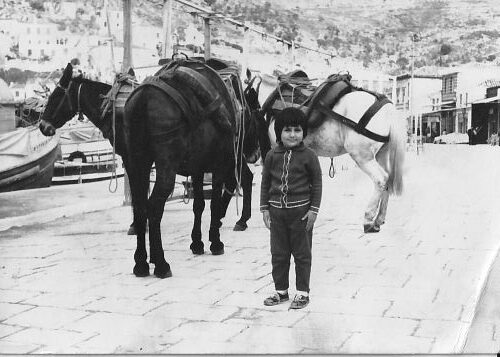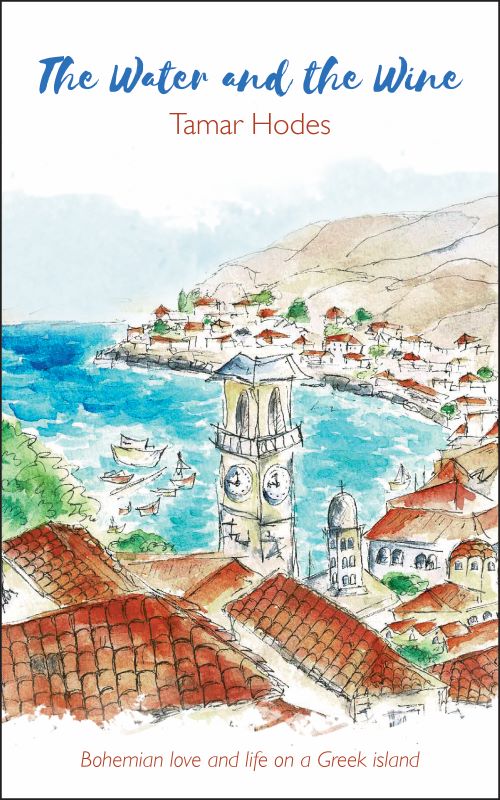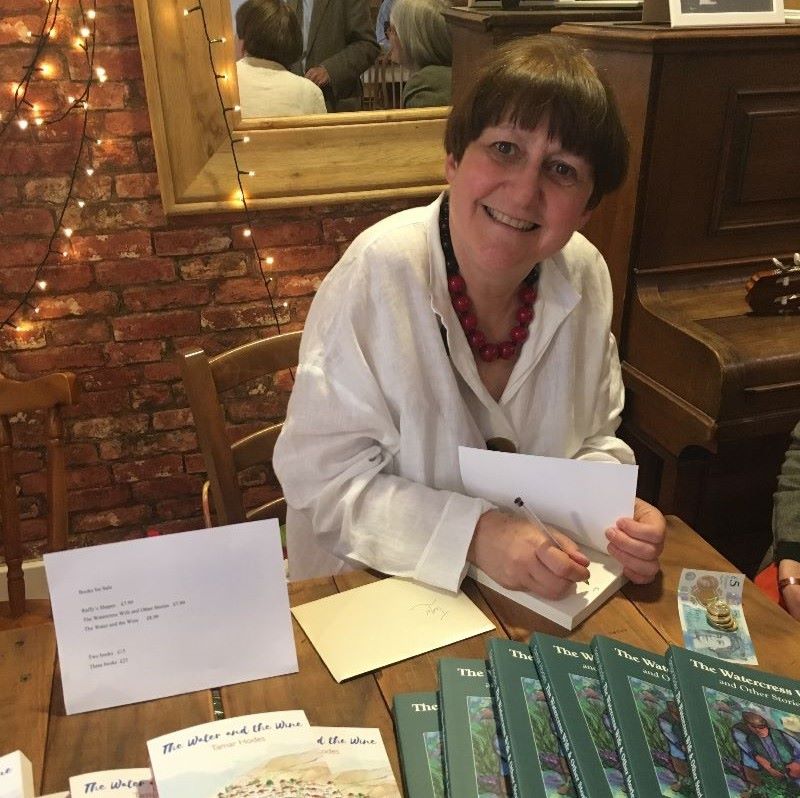by Carolyn Thomas.
This occasional In Common series introduces authors with a connection to Southampton or Hampshire – they may have been brought up here, or live here now, or use the area as a setting for their work.
Kicking things off is Tamar Hodes, currently living in Bassett, Southampton, whose bohemian childhood on the Greek island of Hydra inspired her most successful novel so far; ‘The Water and the Wine’.
**
TAMAR HODES
By their very nature, novels are fictitious, and their authors make things up. But the truism ‘write what you know’ gives many writers an entry point as they draw on aspects of their real life and experiences. This was certainly the case for Southampton-based novelist Tamar Hodes, who thought back to her unusual childhood on the Greek island of Hydra for her 2018 novel The Water and the Wine .
In the 1960s Hydra was home to a hedonistic community of young writers and artists, including the musician Leonard Cohen, his lover and muse Marianne Ihlen, and the Australian authors Charmian Clift and George Johnston.
The lifestyle was wholly bohemian and not an obvious place to bring up a young family. Yet Tamar’s South African parents decided to make the move there in 1965, when she was three and her brother a few years older. ‘My parents were basically hippies’, Tamar explains. ‘My mother was an artist and my father a writer and they had met on a kibbutz.’
 The plan was that her father would write, her mother would paint and they would live happily among a group of like-minded people. There was also the hope that the change of scene would help their marriage, which had hit a rough patch.
The plan was that her father would write, her mother would paint and they would live happily among a group of like-minded people. There was also the hope that the change of scene would help their marriage, which had hit a rough patch.
But nothing about the community in Hydra was likely to help that and Tamar’s parents would eventually divorce.
Many of the adults, who Tamar remembers as ‘complicated and dysfunctional people’ were in tempestuous relationships, fuelled by retsina, hellish and happy by turns – and of course it was not the right environment to shore up a marriage. So eventually Tamar’s parents left the island and, after spending time back in South Africa, the family arrived in the UK, and lived a more conventional life in North London.
Academically inclined, Tamar went on to read English and Education at Cambridge and embarked on a career teaching English and creative writing for adults and children, in a variety of settings, including schools, universities and even prisons. She spent 18 years as an English teacher at Godolphin School in Salisbury, commuting daily from Southampton.
It was her husband’s work as a professor of music which brought the couple to live in Bassett, Southampton, in 2000. And although she can’t remember a time when she didn’t write for pleasure, including producing her first novel when she was just 18, Tamar spent her first years in Southampton working and bringing up her own children. But she continued to write and, in 2006, published her debut novel Raffy’s Shapes.
For many years after that she concentrated on short stories. It’s a format she is passionate about – recommending Alice Munro and William Trevor as masters of the form – and she published her own collection, The Watercress Wife and Other Stories, as well as contributing to other anthologies and writing for broadcast on Radio 4.
 The Water and the Wine came out in 2018, having been years in gestation. ‘Growing up in North London I would often hear my parents talk about our time on Hydra and when I became a writer I always thought that it would make a fascinating novel’, said Tamar. ‘There are many books documenting the time, but a fictional version would allow a writer to go behind the facts and sit at the table with the characters, eavesdrop on their conversations and hopefully understand their desires. As E. L. Doctorow said, “The historian will tell you what happened. The novelist will tell you what it felt like”.
The Water and the Wine came out in 2018, having been years in gestation. ‘Growing up in North London I would often hear my parents talk about our time on Hydra and when I became a writer I always thought that it would make a fascinating novel’, said Tamar. ‘There are many books documenting the time, but a fictional version would allow a writer to go behind the facts and sit at the table with the characters, eavesdrop on their conversations and hopefully understand their desires. As E. L. Doctorow said, “The historian will tell you what happened. The novelist will tell you what it felt like”.
‘For many years, I thought about Hydra and read about it extensively. Then several events happened which compelled me to write my novel. My father sadly passed away in 2013 and left me his journal about that time; my mother died the following year and left me a signed first edition of Leonard Cohen’s poetry collection Flowers for Hitler. Then Marianne Ihlen and Leonard Cohen both died in 2016; it felt like a groundswell beneath me, pushing me to write my book.
‘It was a fascinating process, trying to plait fact, fiction and memory into a coherent whole. At times, I felt exhilarated by it; at other times, very upset by the exploration of the relationships which fell apart.
‘The community on Hydra, including my parents, left mainstream society to focus on creativity and community and that is one of the themes that interests me: do you conform or find an alternative? Do you take the safe route or the risky one? Do you live at the centre of society or on the fringes of it?’
Tamar’s latest novel Mixed develops this idea further. The story is about the conflict between two sisters, arty, liberal Miriam and more strait-laced and conventional Ruth and their different ways of being Jewish in the UK. ‘To be Jewish in a non-Jewish world is not always easy. You have to explain who you are and sometimes defend who you are,’ says Tamar.
‘Yet being an outsider can be useful as a writer,’ she explains. ‘In the same way that we might have to step back to see a painting clearly, it is quite helpful to stand back from the world and view it from afar as well as from inside. Writers are both distanced and involved, maverick but also at the centre. Much of my writing has been concerned with our position in the world, identity and belonging. Many of my short stories have been preoccupied by these issues, which affect all minorities: do you join in and assimilate or live apart from others or find a compromise? What are the consequences of these choices?’
‘I like fiction which asks questions, explores difficult issues, and maybe even provides answers. Writing is a strange paradoxical activity: you write on your own but hope that you are communicating with others; it can come easily, and it can be a struggle; in a sense, you are every character and in a sense, you are none of them.
‘All you can hope is that, when you send your novel out into the world, readers may enjoy it, be moved by it or even be changed by it.’
Tamar is always keen to share her literary expertise, especially through creative writing workshops. Her advice to any In Common readers who may be budding novelists is to read as much good writing as possible, not to copy it but to become inspired. ‘And find the best time for you to write’ she says. ‘For me it’s in the morning. Anything can give me a starting point, I might overhear a snatch of conversation, notice a child examining a flower, see a woman shaking out a rug. Look around you and see where it takes you.’
For further inspiration, read Tamar’s story for Valentine’s Day, Love Among the Branches – see the link below
- We hope you enjoy our website. In Common is not for profit. We rely on donations from readers to keep the site running. Could you help to support us for as little as 25p a week? Please help us to carry on offering independent grass roots media. Visit: https://www.patreon.com/incommonsoton
.

